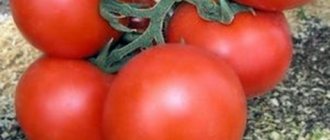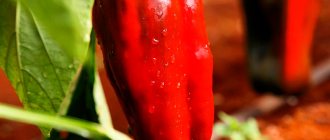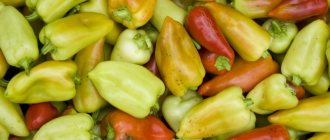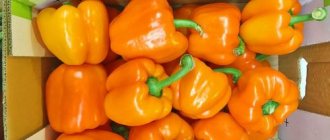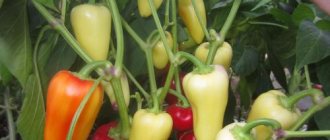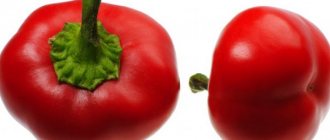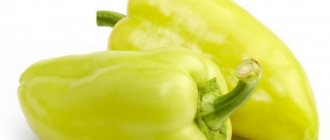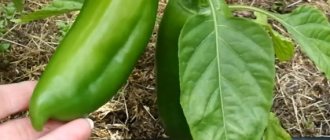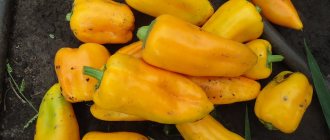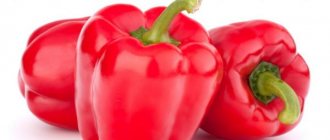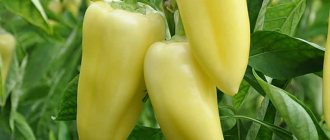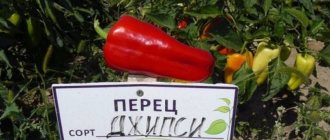Criteria for the Kupets variety
Whatever the characteristics of the variety, it will suit gardeners in all respects. There are types of culture that have no disadvantages and are suitable for everyone. The merchant belongs to this category.
Plant:
- Standard.
- Height 85 cm.
- Ripening period: 110-115 days.
Fetus:
- Shape: pyramidal.
- Weight: 100 g.
- Wall thickness: 8 mm.
- Number of sockets: 2-3 pcs.
- Color: red.
- Pulp: aromatic and juicy.
The final choice always remains with the vegetable grower, who chooses the most suitable variety for the needs of the family.
The best varieties of hot and sweet peppers
Pepper varieties vary in ripening time. This should be taken into account when determining the optimal time for sowing vegetables for seedlings.
Early varieties
Early ripening varieties are among the most popular. Having sowed seedlings at the end of March or in April, they can be planted in a greenhouse or open ground as early as June. And in mid-summer, ripe fruits appear. Early types of vegetables have excellent taste; they can be added to salads and canned.
Among the most famous names:
- Kolobok - red fruits with a smooth glossy surface, weighing 100-170 g, the thickness of the pulp is from 7 to 10 mm. The variety can be planted in the North Caucasus, as well as in the central regions.
- Valentina - ripe fruits are red, elongated, cube-shaped, weight 150-200 g, wall thickness reaches 7 mm. The variety tolerates heat well and is suitable for planting in the south of the country and in the middle zone.
- Sonata is a hybrid variety that grows in 90-100 days and is suitable for planting in greenhouses. The fruits are strong, fleshy, weighing up to 200 g.
- Quickly - the harvest can be obtained already 80-90 days after planting; it tolerates open ground and transportation well.
- Siberian bonus - the fruits weigh 150-200 g, are yellow, the wall thickness is up to 8 mm, they have excellent taste, without bitterness.
- Siberian Prince - the fruits are elongated, cone-shaped, each weight is from 70 to 100 g, they are distinguished by simultaneous ripening in the beds and long shelf life.
Important!
Sweet varieties such as Licedey, Bagration, Nathanya, Winnie the Pooh, Marina, Shchegol, Yaroslav are distinguished by good resistance to adverse weather conditions and diseases. Among the varieties of spicy, there are such as Adjika, Dragon's Tongue, For the Mother-in-Law, and Miracle of the Moscow Region.
Pepper cultivation
Peppers require a lot of attention and care. It is grown mainly by seedlings. Seeds are sown at different periods, the period depends on the day of planting in a permanent place. They begin to sow at the end of February and finish at the beginning of May.
The roots of plants are very delicate; with a slight injury, the entire plant can wither. Therefore, summer residents grow them in separate containers, or peat pots. The latter, in turn, when transplanted into the ground, are an excellent root fertilizer.
After sowing, it is recommended to cover the containers with polyethylene or glass. After sprouting, open immediately.
When 2 true leaves appear, the sprouts are pinched, removing the growth point that is located above them. This helps the peppers form side shoots and stop growing upwards.
When transplanting to a permanent place, it is recommended to place 4 plants per 1m2. 10 days before, begin hardening off the peppers, preparing them for the harsh outdoor growing conditions.
Landing
Peppers are grown only by seedlings. The seeds are sown so that by the time of planting in a permanent place, ready-made seedlings are obtained at the age of 60 days. The seed is placed in a mixture of peat and garden soil, adding a small amount of ash. You can buy ready-made soil adapted for growing nightshades.
Seeds are sown at a distance of 2 cm, between rows - 5 cm. Picking is carried out when 2-3 true leaves appear on the seedlings. Seedlings are kept at a temperature of 20–25 degrees, including lighting in the evenings. If the leaves become pale green, you will need to fertilize with urea (a teaspoon per 5 liters of water).
Caring for the variety
One of the main advantages of Kupets pepper is its unpretentiousness. Therefore, you won’t have to take special care of it:
- Soil moisture should be monitored; plants should not dry out or be flooded with water uncontrollably.
- Remove weeds and periodically loosen the soil. Access to oxygen to the roots is necessary for proper growth.
- Feeding. There is no need to be zealous in this regard. Plants need to be fertilized after transplantation and during fruit appearance. Feeding before the formation of ovaries will lead to the formation of green mass, there will be no flowers or fruits.
- If the pepper blooms within 10 days after transplantation, you need to remove the inflorescences. The plants have not yet taken root, they will become sick and produce a weak harvest.
See also
Why do peppers rot and turn black on a bush in a greenhouse and what to doRead
Application and yield volume
The versatility of the fruits of the Kupets pepper is reflected in numerous reviews from summer residents. The vegetable is suitable for canning, freezing, and eating fresh.
The productivity of the variety, according to the manufacturer, is 3 kg per 1 m2. But with proper care and all the requirements of agricultural technology, 5.5 kg per 1 m2 is collected.
Pros and cons of Kupets pepper
The presence of advantages in the description allows the variety to quickly gain popularity. Positive properties:
- Stable harvest.
- Unpretentiousness.
- Frost resistance.
- Ability to set fruit under unfavorable weather conditions and temperature changes.
- Versatility of use.
- High commercial quality of fruits.
No disadvantages identified.
Description and advantages of the variety
The bushes reach a height of 75-80 cm, compact with a powerful root system. With regular feeding and compliance with planting dates, 17-19 fruits are formed on each plant. Peppers are not large in size; on average, the weight remains at 140-170 grams, with a wall thickness of 6.5-7 mm. The color is red and glossy when fully ripe, while when technically ripe it is light green. The taste of the fruit is sweet with a slight sourness, rich. The pulp is juicy, fleshy, there are few seeds, located in the petiole region.
Advantages:
- good germination;
- persistence in tobacco mosaic;
- cultivation in open and closed ground;
- high productivity;
- formation of the ovary even under unfavorable weather conditions;
- undemanding to soil;
- long shelf life.
The stable yield indicator is 6 - 7.5 kg per 1 sq.m.
Worth considering:
pepper is suitable for use fresh and canned.
pepper Gourmet F1 - description and characteristics of the variety
Opinions of summer residents regarding the Kupets pepper variety
Positive reviews from gardeners work better than any advertising. A novice vegetable grower receives a lot of useful information and specific recommendations.
Nikolay: “I grow “merchant” peppers every year. Externally beautiful fruits do not require care. But the main advantage is in the taste. It is possible to collect the seeds yourself. But it’s better to periodically update the variety, as over the years it loses its characteristics.”
Natalya: “I got acquainted with the variety at the seedling stage. Since I am new to gardening. Unpretentious, grew up in the country, looked after once a week, it was not possible to come more often. The beds were mulched to retain moisture. Next year I will grow it myself, using seedlings.”
Description of pepper varieties Latino, Ekaterina and Kupets, their characteristics and productivity
From year to year, the summer resident selects his own list of varieties that must be grown. Pepper Kupets pleases with its productivity and ability to bear fruit regardless of weather conditions. In addition to this species, there are also Ekaterina and Latino peppers, which are also tall.
Criteria for the Kupets variety
Whatever the characteristics of the variety, it will suit gardeners in all respects. There are types of culture that have no disadvantages and are suitable for everyone. The merchant belongs to this category.
Plant:
- Standard.
- Height 85 cm.
- Ripening period: 110-115 days.
Fetus:
- Shape: pyramidal.
- Weight: 100 g.
- Wall thickness: 8 mm.
- Number of sockets: 2-3 pcs.
- Color: red.
- Pulp: aromatic and juicy.
The final choice always remains with the vegetable grower, who chooses the most suitable variety for the needs of the family.
Pepper cultivation
Peppers require a lot of attention and care. It is grown mainly by seedlings. Seeds are sown at different periods, the period depends on the day of planting in a permanent place. They begin to sow at the end of February and finish at the beginning of May.
The roots of plants are very delicate; with a slight injury, the entire plant can wither. Therefore, summer residents grow them in separate containers, or peat pots. The latter, in turn, when transplanted into the ground, are an excellent root fertilizer.
After sowing, it is recommended to cover the containers with polyethylene or glass. After sprouting, open immediately.
When 2 true leaves appear, the sprouts are pinched, removing the growth point that is located above them. This helps the peppers form side shoots and stop growing upwards.
When transplanting to a permanent place, it is recommended to place 4 plants per 1m2. 10 days before, begin hardening off the peppers, preparing them for the harsh outdoor growing conditions.
Caring for the variety
One of the main advantages of Kupets pepper is its unpretentiousness. Therefore, you won’t have to take special care of it:
- Soil moisture should be monitored; plants should not dry out or be flooded with water uncontrollably.
- Remove weeds and periodically loosen the soil. Access to oxygen to the roots is necessary for proper growth.
- Feeding. There is no need to be zealous in this regard. Plants need to be fertilized after transplantation and during fruit appearance. Feeding before the formation of ovaries will lead to the formation of green mass, there will be no flowers or fruits.
- If the pepper blooms within 10 days after transplantation, you need to remove the inflorescences. The plants have not yet taken root, they will become sick and produce a weak harvest.
Application and yield volume
The versatility of the fruits of the Kupets pepper is reflected in numerous reviews from summer residents. The vegetable is suitable for canning, freezing, and eating fresh.
The productivity of the variety, according to the manufacturer, is 3 kg per 1 m2. But with proper care and all the requirements of agricultural technology, 5.5 kg per 1 m2 is collected.
Pros and cons of Kupets pepper
The presence of advantages in the description allows the variety to quickly gain popularity. Positive properties:
- Stable harvest.
- Unpretentiousness.
- Frost resistance.
- Ability to set fruit under unfavorable weather conditions and temperature changes.
- Versatility of use.
- High commercial quality of fruits.
No disadvantages identified.
Opinions of summer residents regarding the Kupets pepper variety
Positive reviews from gardeners work better than any advertising. A novice vegetable grower receives a lot of useful information and specific recommendations.
Nikolay: “I grow “merchant” peppers every year. Externally beautiful fruits do not require care. But the main advantage is in the taste. It is possible to collect the seeds yourself. But it’s better to periodically update the variety, as over the years it loses its characteristics.”
Natalya: “I got acquainted with the variety at the seedling stage. Since I am new to gardening. Unpretentious, grew up in the country, looked after once a week, it was not possible to come more often. The beds were mulched to retain moisture. Next year I will grow it myself, using seedlings.”
Latino variety criteria
Another variety of tall pepper. The summer resident will fully appreciate its advantages only after he grows it on his plot.
Description of the plant:
- Height: 1 m.
- Ripening period: 100-110 days
Peppers:
- Shape: cuboid.
- Color: red.
- Wall thickness: 8-10 mm.
- Fruit weight: 180-200 g.
- Taste: rich and aromatic.
- Can be stored for a long time.
Thus, Latino pepper meets many characteristics. Especially for those summer residents who cannot devote much time to caring for their crops.
Advantages of pepper
The vegetable grower evaluates the advantages, according to reviews from those who grew it on their plots. Often a large number of disadvantages leads to the fact that a variety becomes unpopular.
Positive characteristics:
- Productivity.
- Great taste.
- Unpretentiousness.
- Versatility of use.
- Resistance to TMV.
- Independence from weather changes.
Negative characteristics:
- Hybrid seeds do not retain maternal genes.
Some positive properties will seem to the gardener, on the contrary, as disadvantages of the variety, so everyone evaluates from their own experience and preferences.
Features of cultivation
Latino is no different from other hybrids in planting and care. The main agricultural techniques are watering, fertilizing, and loosening. 4 plants are planted per 1 m2.
Formed into 2 stems and tied to supports.
Hybrid immunity. Use of vegetables. Productivity.
Latino peppers are resistant to tobacco mosaic virus. Preventative treatments are required against insect pests and other diseases.
Vegetables are universal in use, eaten fresh, canned and frozen.
14 kg of pepper is collected from 1 m2.
The opinion of summer residents regarding the Latino hybrid
Reviews from vegetable growers help a novice gardener avoid the mistakes that are most common when growing crops.
Nina: “The fruits are large, the walls are thick, the peppers are tasty and juicy.”
Lena: “I grew a Latin miracle on my plot. I liked the pepper, just like in the store, tasty, large and thick-walled.”
Criteria for the variety Ekaterina
After reading the description of the variety, gardeners know exactly whether the species is suitable for the needs of a particular family or not.
Plant:
- Indeterminate.
- Height: 70-80 cm.
- There are 18-20 peppers on one bush.
- Ripens within 110-112 days.
Pepper:
- Shape: cylindrical.
- Color: red.
- Weight: 110-170 g.
- Length: 15 cm.
- Diameter: 6.5-7.5 cm.
- Wall thickness: 6-7 mm.
- It is stored for a long time, maintaining its presentation.
The tall variety of pepper Ekaterina is universal in use and resistant to disease, so those summer residents who grew it will not exchange it for any other.
Growing
It is recommended to tie them to trellises, as plants break due to the abundance of fruits on the bushes. Forming it into 2 stems. They use the seedling growing method, which significantly reduces the time before fruiting begins. 3-4 plants are planted per 1 m2. Otherwise, care is the same as for other varieties of crops.
Harvest volume and application. Hybrid immunity
If all agrotechnical practices are followed, 6-7 kg of fruits are obtained from 1 m2. Use for any purpose, canning, freezing or fresh salads.
Pepper Catherine is not susceptible to tobacco mosaic virus. Other diseases are combated by applying timely preventive measures.
The opinion of summer residents regarding the hybrid Ekaterina
The decisive criterion in making a decision as a vegetable grower is the presence of a large number of positive reviews.
Yuri: “It was a bad spring, a cold summer, but the pepper still produced an excellent harvest. I liked the large, fleshy, large fruits of the hybrid.”
Tatyana: “Very good pepper. Productivity is beyond praise. The only negative is that it is not suitable for stuffing, but the entire harvest was used for making salads. I will definitely grow more.”
Pepper lovers will be pleasantly surprised by the unpretentiousness of these tall varieties of the crop.
dachamechty.ru
Latino variety criteria
Another variety of tall pepper. The summer resident will fully appreciate its advantages only after he grows it on his plot.
Description of the plant:
- Height: 1 m.
- Ripening period: 100-110 days
Peppers:
- Shape: cuboid.
- Color: red.
- Wall thickness: 8-10 mm.
- Fruit weight: 180-200 g.
- Taste: rich and aromatic.
- Can be stored for a long time.
Thus, Latino pepper meets many characteristics. Especially for those summer residents who cannot devote much time to caring for their crops.
Advantages of pepper
The vegetable grower evaluates the advantages, according to reviews from those who grew it on their plots. Often a large number of disadvantages leads to the fact that a variety becomes unpopular.
Positive characteristics:
- Productivity.
- Great taste.
- Unpretentiousness.
- Versatility of use.
- Resistance to TMV.
- Independence from weather changes.
Negative characteristics:
- Hybrid seeds do not retain maternal genes.
Some positive properties will seem to the gardener, on the contrary, as disadvantages of the variety, so everyone evaluates from their own experience and preferences.
See also
Description of pepper varieties Khalif, Antey and Flamenco, cultivation and yield with photosRead
Features of cultivation
Latino is no different from other hybrids in planting and care. The main agricultural techniques are watering, fertilizing, and loosening. 4 plants are planted per 1 m2.
Formed into 2 stems and tied to supports.
Hybrid immunity. Use of vegetables. Productivity.
Latino peppers are resistant to tobacco mosaic virus. Preventative treatments are required against insect pests and other diseases.
Vegetables are universal in use, eaten fresh, canned and frozen.
14 kg of pepper is collected from 1 m2.
Features of agricultural technology
Pepper Ekaterina F1 should be cultivated using the seedling method. Principles of planting and caring for a hybrid:
- seedlings are ready to move to the beds at 60 days of age;
- the soil where pepper will develop must be enriched with nitrogen, phosphorus, and potassium;
- the optimal number of plants per 1 m2 is 3 – 4 units;
- pepper should not be watered with cold water;
- frequency of soil irrigation - every 2 - 3 days;
- when applying fertilizing, organic and mineral fertilizers should be alternated;
- The pepper is formed into 2 stems and strengthened with trellises.
Sowing seeds for seedlings | Planting seedlings in a greenhouse/greenhouse | Planting seedlings in exhaust gas | Stepsoning | Harvesting |
| 20.02 – 10.03 | The end of May | The beginning of June | Removing lateral shoots to form 2 main stems | July - September |
| *dates are indicated for central Russia | ||||
Criteria for the variety Ekaterina
After reading the description of the variety, gardeners know exactly whether the species is suitable for the needs of a particular family or not.
Plant:
- Indeterminate.
- Height: 70-80 cm.
- There are 18-20 peppers on one bush.
- Ripens within 110-112 days.
Pepper:
- Shape: cylindrical.
- Color: red.
- Weight: 110-170 g.
- Length: 15 cm.
- Diameter: 6.5-7.5 cm.
- Wall thickness: 6-7 mm.
- It is stored for a long time, maintaining its presentation.
The tall variety of pepper Ekaterina is universal in use and resistant to disease, so those summer residents who grew it will not exchange it for any other.
What to plant in a greenhouse: choosing a variety
For indoor soil, it is best to choose sweet varieties such as:
- Apricot is a favorite - the fruits are very juicy, grow up to 150 g, the color is rich yellow, orange. Among the advantages are high productivity and low maintenance requirements.
- Agapovsky is an early ripening variety; ripe vegetables are very juicy and aromatic. The variety is characterized by high yield and disease resistance.
- Belladonna is an early, high-yielding pepper; the color of mature peppers is yellow. The variety is resistant to viruses, retains its presentation for a long time, and tolerates transportation well.
Of the acute species, it is recommended to plant Double Abundance and Astrakhan under film. The first variety is distinguished by the duration and abundance of fruiting. The weight of one vegetable is 50-80 g. Astrakhan - peppers grow up to 10 cm in length, weigh 20 g each, the color when ripe is red or green, they are high-yielding, especially spicy varieties.
The opinion of summer residents regarding the hybrid Ekaterina
The decisive criterion in making a decision as a vegetable grower is the presence of a large number of positive reviews.
Yuri: “It was a bad spring, a cold summer, but the pepper still produced an excellent harvest. I liked the large, fleshy, large fruits of the hybrid.”
Tatyana: “Very good pepper. Productivity is beyond praise. The only negative is that it is not suitable for stuffing, but the entire harvest was used for making salads. I will definitely grow more.”
Pepper lovers will be pleasantly surprised by the unpretentiousness of these tall varieties of the crop.
